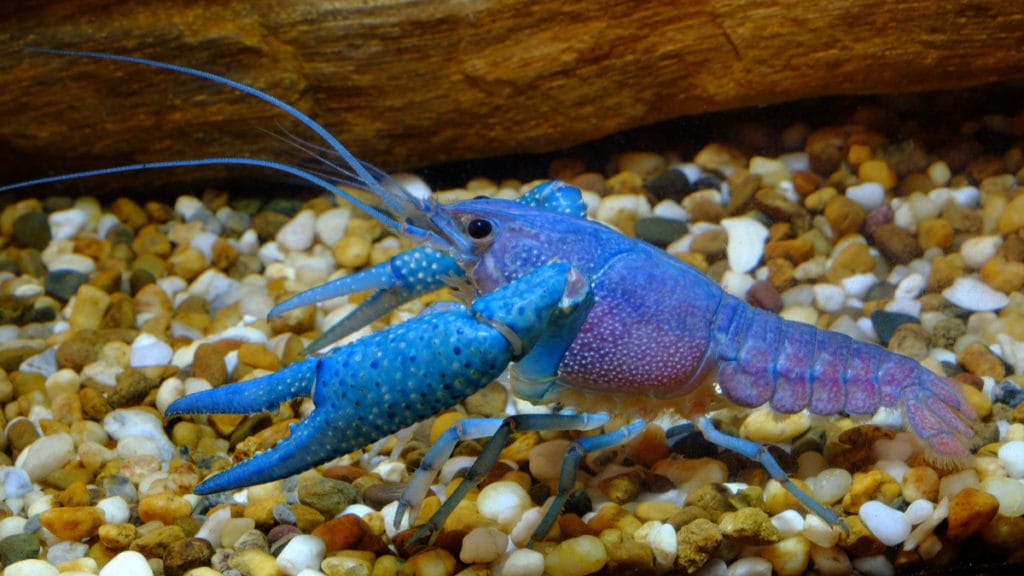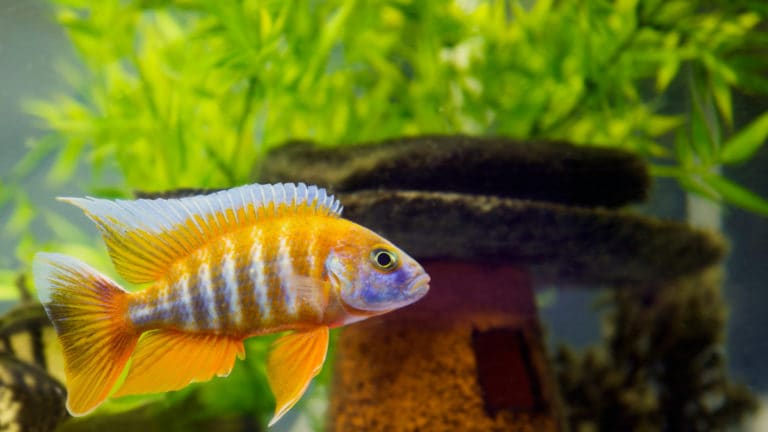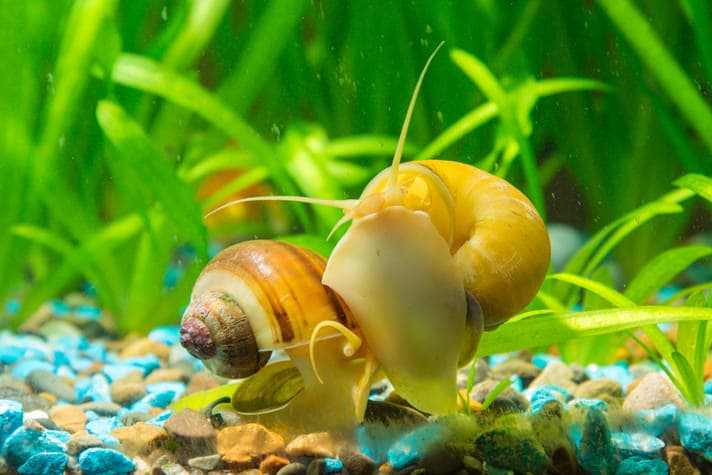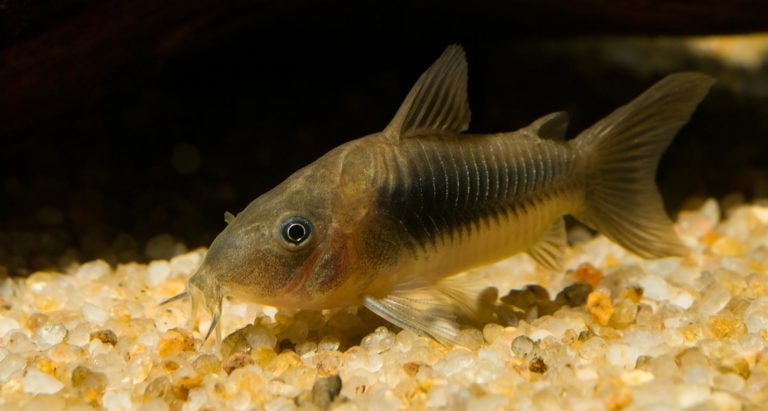Crayfish, can be very interesting but it is often difficult to identify a species or even find information about its requirements in captivity. Before learning about some possible aquarium crayfish, we need to cover the basics of these intriguing invertebrates.
Crayfish are found in a variety of habitats. Occasionally, they are found in brackish water, and some species can survive in saltwater for several days, but no marine habitats are permanent locations for crayfish. They are solitary animals that reside in dens or crevices, which they defend against intruding species members.
This aggressive behavior can change under certain conditions, however. For example, some species, such as Orconectes virilis, are passive when they molt or just before. In some species, too, aggression depends on temperature. A rising or falling temperature may be a spawning trigger, depending on the species, and then the aggression is proportional or inversely proportional with the rise in water temperature. The pH is not generally an important factor with captive specimens.
Fish That Can Be Kept With Crayfish
With the small crayfish (such as Cambarellus), you can keep neon tetras, mollies, platies, swordtails and small catfish like Ancistrus.
With the bigger crayfish (like Cherax destructor), you can keep small fish as well as bigger fish like Aulonocar and Pseudotropheus (Malawi and Tanganyika cichlid fish ), catfish like Ancistrus, Gibbiceps, South American cichlid fish, barbs, goldfish and labyrinth fish.
Normally the crayfish’s claws are too big and heavy to allow them to catch small, fast fish. One factor to keep in mind: When you buy a crayfish and put it in the tank, the fish will normally need about two or three days to get used to the fact that they are now sharing space with a creature that can catch them.
Crayfish are omnivorous. They eat plants and plant matter, detritus and wood, roots and, in many caves, bat guano. They are predators that hunt small invertebrates, such as snails, mussels, leeches and worms, and will eat their own kind on occasion.
In the fish aquarium, they will eat all offered foods, including frozen red worms, snails, mussels, shrimp, krill and artemia; fresh carrots, corn and cucumbers (try nearly any vegetable); and all kinds of dried fish foods, such as flakes, wafers and tablets. They’ll sometimes eat fish and plants (frogs, too), but fish are seldom eaten because crayfish normally are not able to catch healthy animals. Injured, sick or recently killed fish and amphibians, however, are a welcome treat and eagerly eaten by crayfish.
Growth And Shell Replacement
Crayfish have a flexible exoskeleton (its “shell”) that is repeatedly shed as the animal grows. When an old shell becomes too tight, the crayfish prepares to shed it. The entire process of developing a new, hardened shell may take days or weeks to complete, but the actual shedding may be finished in minutes.
A crayfish will stop eating three days to a week before a shed. It will be more active during the day and much more aggressive toward other crayfish. Increasingly dark, transparent edges show on the stomach and edges of the carapace. Immediately prior to shedding (or possibly a few hours before), these areas may break open.
During shedding, the crayfish will lie slightly on its side. First, the eyes and antennae are freed, followed by the claws and legs. Finally, the animal frees itself of the remaining shell on its tail by exerting some strong movements. Exhausted from the process, the crayfish now seeks shelter and rests.
The new shell is still soft and pliable, and during this time the crayfish is at the mercy of its enemies. It is now easy prey. The danger of crayfish cannibalism is not as great as is often assumed. If another crayfish comes too close, the newly shed animal will assume a defensive position, standing tall with closed claws raised high toward the approaching intruder.
Occasionally, crayfish are unable to free themselves of the old shell and die. It is also possible that some limb sections will break off in the process because they are stuck in the old shell. Difficult sheds such as this can result in weakened animals that are more susceptible to predators and intruders.
After several days the new shell hardens, and the crayfish is able to resume its normal life. The shed exoskeleton — a source of calcium — is typically eaten by its owner or other crayfish.
Prior to the shed, the crayfish absorbs calcium carbonate from its exoskeleton and secretes it to form white half-spheres called gastroliths (also known as “crayfish rocks”) in its stomach. During shedding, the gastroliths are dissolved in the stomach fluid, releasing calcium to harden the next exoskeleton.
Crayfish can regrow lost limbs over several sheds, and a regrown limb has full function. If a crayfish loses a limb shortly after a shed, it will be replaced immediately with a smaller, weaker one.
Young crayfish that shed more frequently are able to regain functional, normal-size limbs faster than older or adult animals. For these latter crayfish, the claws may never reach their former size again. Now let’s examine eight crayfish species that make interesting aquarium inhabitants.
Louisiana Crayfish (Procambarus clarkii)
Description:
Procambarus clarkii was one of the first crayfish species popularized in the aquarium hobby. As a rule, these red crayfish will live for two to three years, or a little longer, in the aquarium.
Range:
The Nile river
Adult size:
6 inches
Aquarium conditions:
This crayfish can adapt to many captive setups. In an aquarium, they are escape artists — I’ve observed them climbing 20 inches out of the water on the power cable of a filter, grasping the cable alternately with their claws. Crayfish tanks should always be well covered.
Yabby OR Australian Crawfish (Cherax destructor)
Description:
As with many crayfish species, the yabby has a bright blue color form that is very popular in the hobby. The maximum age of this species in the wild is 4 to 5 years, but they can live considerably longer in the aquarium.
Range:
Australia, in all of Victoria, New South Wales, southern Queensland, South Australia and parts of the northern territory
Adult size:
8 inches, with females usually remaining smaller than males of the same age
Aquarium conditions:
The ideal temperatures for keeping or breeding yabbies is 68 to 82 degrees Fahrenheit. They have a wide temperature tolerance, but at temperatures below 60 degrees they stop growing, whereas temperatures above 95 can cause them to stop growing or die.
Notes:
Cherax destructor is called by the aboriginal name of “yabby” in its native country. The species name destructor means “destroyer,” which is not too accurate because this species is less aggressive than many other crayfish. Wild yabbies are usually found in cloudy, slow-moving water with heavy vegetation. They also do well in warm inland ponds, and in ditches and swamps with many hiding places that afford cover from predators.
Yabbies can survive for months out of the water as long as their gills are kept moist, and during dry spells they can survive a long time deep in their tunnels. As the water level drops, the crayfish will dig deeper — some tunnels have been found with a depth of 16 feet.
To compensate for losses when young fall prey to other animals, a female C. destructor can produce from 500 to 1,000 young a year, depending on her size. The higher the temperature, the faster the young develop. Egg incubation at summer temperatures of 73 to 75 degrees Fahrenheit takes about three weeks. When it’s really cold (62 to 68 degrees), incubation can take four to five weeks.
The first young usually hatch out only three weeks after eggs are laid. Tiny hooks on their legs allow them to hold on to the fine hairs of the female’s pleopods (abdominal limbs). While carrying eggs and young, females try to remain hidden and are usually found in caves under rocks or roots. They may be so exhausted from the spawning that they’ll hide for days and come out only occasionally to eat. Offer many hiding places in the aquarium, and do not disturb the carrying females. If disturbed, a female may eat the entire spawn.
Florida Lobster (Procambarus alleni)
Description:
In nature, this species is usually uniform brown. It may have some darker spots on the upper body and is lighter at the bottom. The warts on the claws are yellowish, and the claws themselves may have a blue shine. The blue color variant of this species has conquered aquariums around the world (the blue coloration is due to an enzyme defect and is passed on recessively).
Range:
Florida, east of the St. Johns River and across the entire southern peninsula from Marion and Levy Counties to the Florida Keys
Adult size:
2.3 inches for males; females are 2.75 inches
Aquarium conditions:
Optimal temperature in the aquarium should be between 68 to 80 degrees.
Notes:
Procambarus alleni inhabits standing waters in Florida and digs short tunnels when the water level falls. The number of young depends on the size of the female; smaller females have 100 to 150 young, while larger ones can produce up to 300. The young grow rapidly during the first few weeks, and they shed every couple of days, depending on the temperature.
Breeding Florida Lobsters
Procambarus alleni, especially the blue form, is very popular in home aquariums. Here’s what to expect if you have a pair.
Mating begins with the male grabbing the female with a claw and trying to flip her onto her side or back. The hooks on the base of the male’s legs are then used as claspers, fitting onto the legs of the female. The male’s sperm tube will then push through a crevice in one of his pleopods, and sperm is released and deposited in the female’s analus ventralis (a kind of pocket used to hold the sperm) with the tip of the male’s other pleopod. Mating takes about 15 minutes. Usually within hours afterward, the female starts to clean the setal fringes on her abdomen and begins to lay eggs.
The eggs remain suspended on the female’s underside, where they are kept free of debris and oxygenated by the constant movements of her swimmerettes. During this time, the female rarely leaves her hideout, and eats little or not at all.
After about three weeks, the young crayfish leave the female and move around the aquarium freely. Young crayfish should be housed in an aquarium with a large surface area and many hiding places (in my aquariums, I use clay bricks with holes). Some young may be eaten by their siblings, but if the young are fed several times a day, losses should be minimal.
Shufeld’s Dwarf Crayfish (Cambarellus shufeldtii)
Description:
This is a small red-brown or gray crayfish with dark horizontal bands or loosely arranged dots in rows. There are two forms of C. shufeldtii in both sexes: a striped and a spotted or marbled form. Their claws are small, elongate and smooth. The spiny warts found on the claws of many North American species are absent. With a maximum age of 15 to 18 months, the males get older than the females but also take longer to reach sexual maturity.
Range:
Distributed from the Gulf Coast of south central Texas to southwestern Alabama, and north along the Mississippi River to Lincoln County, Missouri
Adult size:
1.5 inches
Aquarium conditions:
Their small size and minimal aggression make this species ideal aquarium inhabitants that may be kept with plants and fish (neon tetras, mollies, guppies, platies, swordtails and small catfish like Ancistrus spp.) They can be kept without a heater.
Notes:
Females live up to one year, during which time they may lay eggs twice, carrying them for about three weeks. The average number of eggs is between 30 and 40.
Orange Dwarf Crayfish (Cambarellus patzcuarensis)
Description:
This much sought-after species, recently imported from Europe to the U.S., is orange with two stripes along the side.
Range:
Endemic in a lake of volcanic origin 9,186 to 9,842 feet above sea level in the northern part of the Mexican state of Morelos; the surrounding vegetation at the Laguna de Zempoala is alpine and is the only place the species is found.
Adult size:
1.6 inches
Aquarium conditions:
Larger fish, such as cichlid fish and eels, will eat the young of this crayfish (and sometimes the adults, too). Tetras, livebearers and dwarf cichlid fish are ideal community fish to keep with orange dwarf crayfish. They can be kept without a heater.
Red Claw (Cherax quadricarinatus)
Description:
Adults of this species are easily recognized by the elongate, bubblelike growths on the claws of males. Their color can be blue-green or blue to almost black, with yellow spots on the carapace. Yellow lines and pink spots appear on the abdomen.
Range:
Northern Australia, where it inhabits the rivers of northern Queensland and the Northern Territory
Adult size:
8.5 inches
Aquarium conditions:
This larger species requires a tank that is at least 40 inches long and 20 inches deep. It breeds at temperatures of 72 to 90 degrees. If the temperature continues to rise, they will stop breeding but are able to survive in well-oxygenated water up to 95 degrees. If the water temperature remains below 55 for extended periods of time, this crayfish will die.
Notes:
In nature, Cherax quadricarinatus are often found under roots or rocks, where they hide from predators and other species members. Females are very productive, maturing after about one year, and may breed three times annually, laying 500 to 1,500 eggs. The eggs are carried under the abdomen for 45 days until the young hatch. Wild red claws feed mostly on detritus and small water organisms living in the layers of leaves and plant material on the bottom of lakes and ponds.
The Marron (Cherax tenuimanus)
Description:
Australian breeders have told me the blue variant of this crayfish is an albino, while the normal color is brown or black. Recently a new subspecies was discovered, one with a carapace that’s covered with fine hairs on top (this subspecies varies genetically from C. tenuimanus and may soon be described as a new species [pers. comm., Chris Austin]).
Range:
West Australia from the Murray River on south to the Kent River (near the city of Albany) as well as north to the Chapman River (near the city of Generaltown) and southeast in the rivers around Esperance
Adult size:
15 inches and up to 4 pounds
Aquarium conditions:
With this species, temperature, population density and food availability are important factors to determine growth. It is sensitive to higher temperatures, so the aquarium should be placed where temperatures do not exceed 80 degrees (ideal temperatures are 60 to 72). The tank should be at least 60 inches long by 20 inches deep, and it should be well oxygenated. In nature, mass die-offs of this species have been recorded when temperatures rise above 80 degrees during the summer. Cherax tenuimanus are solitary animals that are very aggressive toward their own kind. When they are fed, a social hierarchy can be observed. The larger, dominant animals feed first, resulting in them growing even faster. Keeping these crayfish together is difficult because the larger ones always threaten to eat the smallest of the group.
Notes:
Breeding this species is difficult. Females begin to breed in their third year of life, rarely in their second. A very high dissolved oxygen content is important during the breeding season. The number of eggs for a small female is around 90, while larger females can carry up to 900.
Miami Cave Crayfish (Procambarus milleri)
Description:
Color varies from intense orange to yellow-orange; even young exhibit orange coloration. Unlike the closely related P. alleni, the males of which have the longer claws, male and female P. milleri have equally long claws. The bright orange color of this crayfish is most impressive in aquariums with dark gravel and subdued lighting. It is an ideal species for aquarists who are interested in keeping a colorful crustacean in a community tank with fish.
Range:
Miami, Florida
Adult size:
3 inches
Aquarium conditions:
The temperature for this species should be between 68 and 86 degrees, and water should be slightly alkaline and hard. They have not been observed to display the aggression or territorial defenses of other crayfish. Even in densely populated breeding tanks, this species is more tolerant toward its own kind than other species. They are also more tolerant of other species.
Notes:
This species may breed all year long; the female will attach several dozen to 100 (depending on her size) large black eggs to her abdomen. The young may be raised in the same tank as the parents, provided that there are no fish in the aquarium that will eat them.
I hope this introduction to crayfish has piqued your interest in these incredible animals. Give your crayfish a proper home, and they are sure to provide you with much enjoyment.
Featured Image: Nattapon Somsawath/Shutterstock.com
By: Chewy Editorial
Share:









